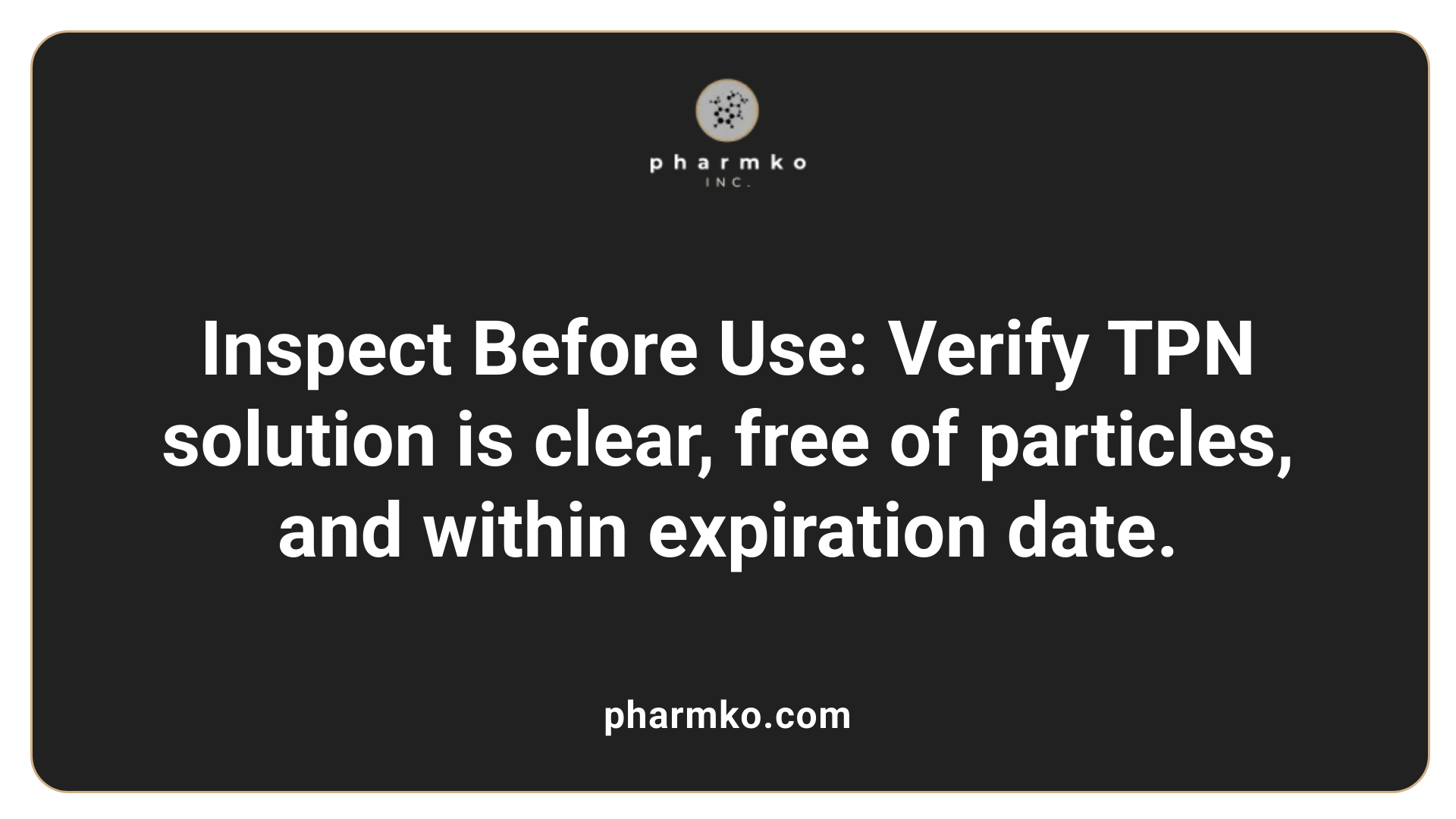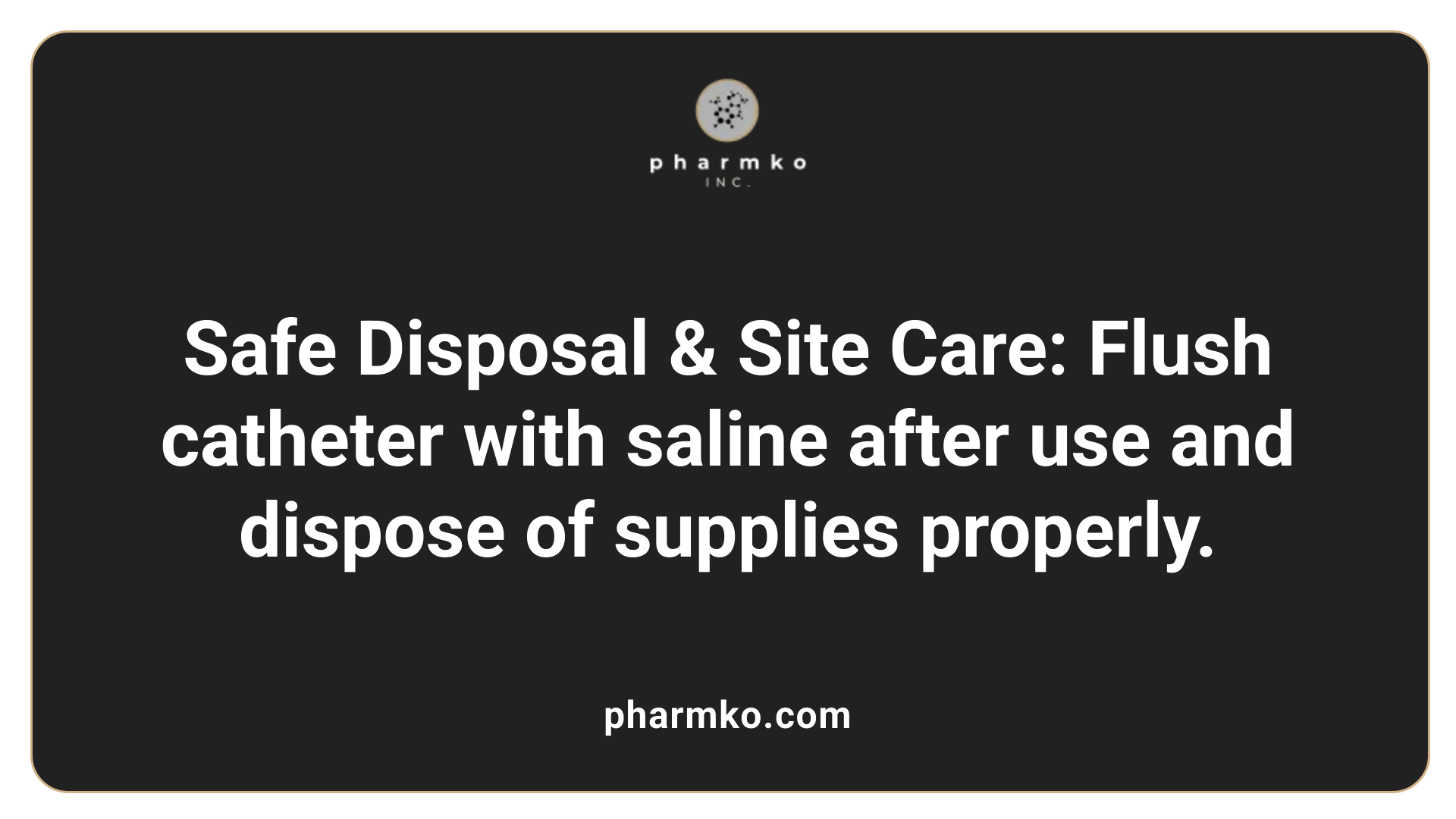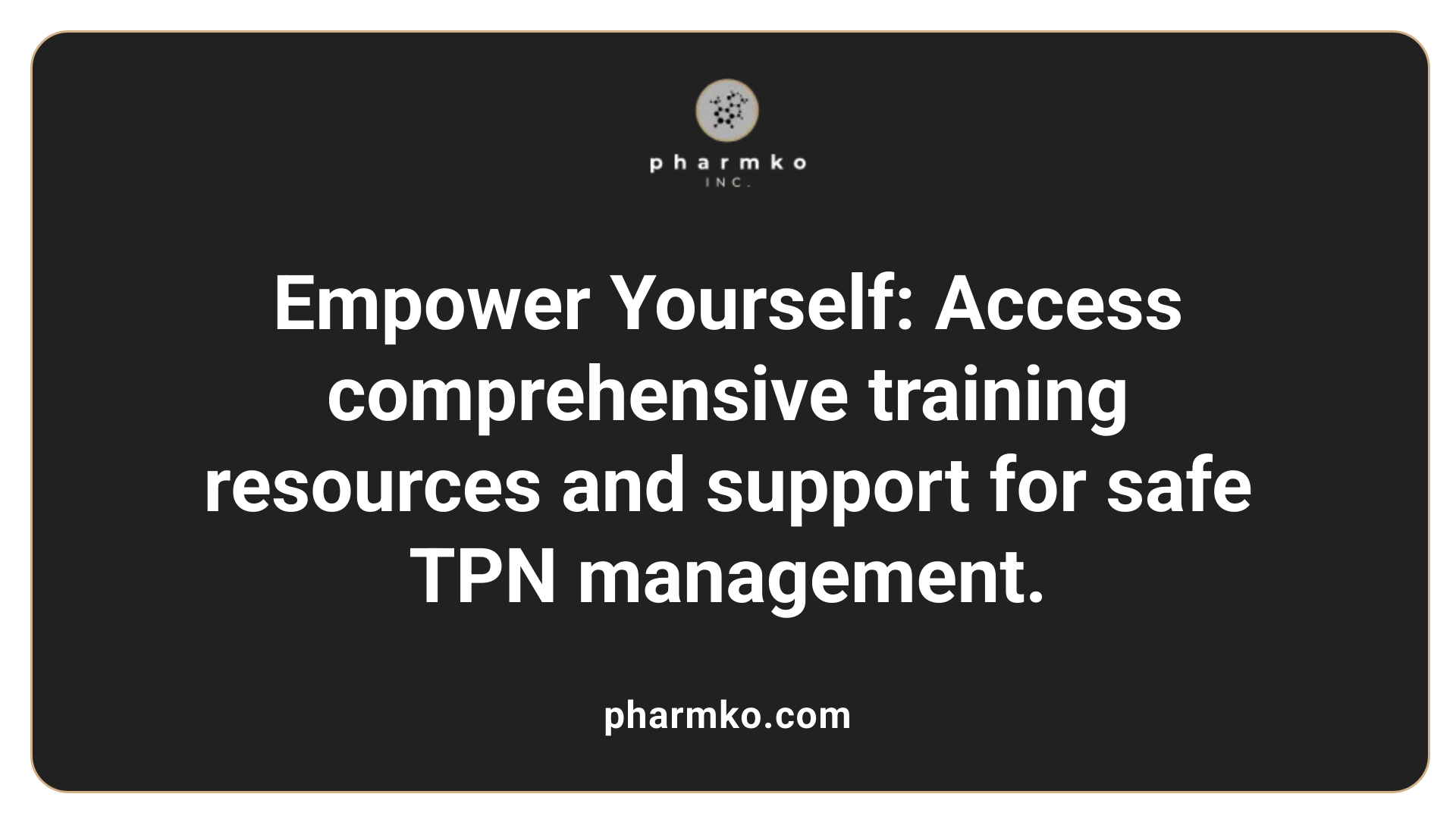How to Educate Patients and Families on TPN Administration at Home
Understanding the Importance of Education in Home TPN Care
Total parenteral nutrition (TPN) is a complex but vital therapy that delivers essential nutrients directly into the bloodstream for patients unable to meet nutritional needs through oral intake. Proper education for patients and families is crucial to ensure safety, effectiveness, and independence in home TPN management. This article explores the key principles, procedures, safety measures, and resources essential for empowering caregivers and patients to successfully administer TPN at home.
Foundations of Safe TPN Administration at Home
What are the principles for safe TPN tubing setup and administration?
Administering Total Parenteral Nutrition (TPN) safely at home relies on several fundamental principles. First and foremost, strict sterile and aseptic techniques are crucial to prevent infections. This means thoroughly washing hands before handling supplies, disinfecting port access points with alcohol wipes, and using sterile gloves during preparation and connection.
Before starting, inspect the TPN bag carefully. Ensure it has not expired, and verify that the solution appears clear and free of particles or discoloration. The integrity of the bag should be intact with no leaks.
Proper setup involves securely attaching the tubing to the TPN bag and making sure all connections to the central venous catheter are tight and correctly positioned. Priming the tubing is an important step to eliminate air bubbles; this involves filling the tubing with fluid to prevent air from entering the bloodstream.
During infusion, monitor the flow rate and ensure that the tubing remains securely connected to avoid dislodgement. Flushing the catheter with saline before and after TPN administration maintains line patency and reduces the risk of clotting or infection.
Once treatment is complete, dispose of used supplies according to established protocols, using sharps containers for needles and proper waste disposal methods for tubing and bags. Throughout, following the specific protocols and guidelines provided by healthcare professionals ensures safety and optimal therapy effectiveness.
Maintaining these principles helps minimize complications, such as infections, line dislodgement, or air embolism, making home TPN a safe option for long-term nutritional support.
Proper Storage and Preparation of TPN Solutions

Refrigeration requirements
Total Parenteral Nutrition (TPN) solutions must be stored carefully to ensure their safety and effectiveness. They should be kept in a refrigerator set at a temperature of 35°F (1.6°C). Proper refrigeration prevents bacterial growth and maintains the stability of the nutrients within the solution. It is also important to store TPN in a separate, dedicated refrigerator to avoid contamination from other foods.
Before use, always verify that the TPN bag is properly refrigerated and has not exceeded its expiration date. Store unopened bags at the correct temperature, and only take out the amount needed for timely preparation, keeping the rest refrigerated.
Checking for solution integrity
Prior to administering TPN, patients or caregivers must inspect the solution carefully. Check the bag's appearance, ensuring it is clear and free from any particles or cloudiness. Any discoloration, solid particles, or leaks indicate that the solution is compromised and should not be used.
Observe the bag for any signs of contamination, such as cloudiness or separation of layers. Ensure the bag has not exceeded its expiration date, which is printed on the label. Additionally, assess the solution's temperature; it should be at room temperature for infusion, not cold or warm from the refrigerator.
Preparation steps before infusion
Preparation of TPN for infusion involves several sterile procedures to prevent infection and ensure proper delivery. First, wash hands thoroughly with soap and water or use an alcohol-based hand sanitizer. Prepare a clean, flat work surface, disinfected with appropriate cleaning agents.
Check the TPN bag again before use, confirming it is within the expiration date and matches the prescribed formulation. When ready, wipe the bag's ports and medication addition sites with alcohol pads to disinfect them.
If medications or vitamins are to be added, follow sterile procedures: check labels carefully, wash hands, and use sterile syringes and caps to add them. Once prepared, prime the infusion tubing by filling it with sterile solution to remove air bubbles. Attach the tubing securely to the TPN bag and to the infusion pump, ensuring all connections are sterile.
Connect the tubing to the patient's central venous catheter (CVC) following strict aseptic technique. Confirm that the infusion setup is correct, the pump is programmed properly, and all safety checks are completed before starting the infusion.
Routine checks and adherence to these storage and preparation steps are vital for safe TPN administration at home, reducing the risk of infections and ensuring optimal nutrient delivery.
Connecting and Starting TPN Infusion Safely

Attaching TPN to pump and catheter
The first step in starting TPN infusion is securely attaching the TPN solution to the infusion pump and ensuring proper connection to the central venous catheter (CVC). It is crucial to maintain sterile technique throughout this process. Before connecting, verify that the TPN bag is within its expiration date, free from leaks, and appears clear without particles or discoloration.
Next, connect the TPN tubing to the port on the bag, ensuring a secure and tight fit to prevent air leaks or disconnection during infusion. The tubing is then connected to the catheter port, typically after disinfecting the port again with an alcohol wipe to lower infection risk. Proper securement prevents accidental dislodgment, which can cause complications.
Priming the line
Priming involves flushing the tubing with a small amount of saline to expel air and establish a clear, bubble-free line. This step is essential to avoid air embolism and ensure the proper flow of nutrients. After priming, inspect the tubing for bubbles or kinks, and confirm that the infusion line is ready.
Before initiating the infusion, double-check all connections. Sometimes, a designated sterile cap or filter is used to maintain sterility during priming, and the line is carefully inspected for contaminants.
Starting the infusion process
To begin the TPN infusion, hang the prepared bag on the infusion pump—a device that controls the rate and total amount of nutrients delivered. Connect the primed tubing to the pump, then set the infusion rate according to the healthcare provider’s order, which may be over 10 to 24 hours.
Secure the line to prevent movement and check that the pump settings are correct. Finally, connect the line to the central catheter, ensuring a secure attachment. Initiate the pump and monitor the initial flow to detect any issues such as leaks, alarms, or dislodgement.
Throughout infusion, observe the site and monitor patient response, looking out for signs of complications like discomfort, redness, or swelling. Once the infusion completes, follow protocols for disconnection, flushing the line with saline, and safe disposal of all used supplies.
Following these steps rigorously helps ensure a safe, effective, and infection-free TPN therapy at home.
Disconnection and Disposal Procedures

How do I properly flush the central venous catheter (CVC) after TPN infusion?
Flushing the catheter is a crucial step in maintaining line patency and preventing infections. Before disconnecting your TPN line, wash your hands thoroughly with soap and water. Put on sterile gloves and clean the catheter port with an alcohol wipe or chlorhexidine swab. Attach a syringe filled with sterile saline and gently flush the line, ensuring all residual medication is cleared and the line remains open.
What is the correct way to dispose of supplies used during TPN administration?
Proper disposal of TPN supplies is essential for safety and infection control. Used needles, syringes, and glass containers should be placed immediately into a sharps container. Empty TPN bags, tubing, and other waste should be disposed of in accordance with local biohazard or sharps disposal regulations. Do not reuse or repurpose any disposable supply. Always follow your healthcare provider's instructions and local guidelines for waste management.
How should I care for the site after disconnecting TPN?
Post-infusion care involves inspecting the catheter insertion site for signs of infection like redness, swelling, or discharge. Gently apply an sterile dressing if recommended, and ensure the area remains clean and dry. Notify your healthcare provider if you observe any signs of infection, bleeding, or discomfort at the site.
What precautions are necessary for safe TPN tubing setup and administration?
Ensuring safe TPN setup involves strict adherence to aseptic techniques. Always wash your hands thoroughly before handling supplies. Disinfect all ports and connection points with alcohol wipes to reduce bacterial contamination. Confirm that the TPN bag has not expired and appears clear and intact. When connecting the tubing, do so securely to prevent dislodgement or air leaks. Priming the tubing to eliminate air bubbles helps avoid air embolism risks. During infusion, monitor the pump and your patient’s response carefully.
Additional tips for home TPN care
| Step | Action | Additional Details |
|---|---|---|
| Flushing | Use sterile saline | Before and after TPN infusion to clear the line |
| Disposal | Follow protocols | Dispose of needles and tubing in sharps container |
| Site Care | Keep dry and clean | Watch for infection signs, change dressings as advised |
| Monitoring | Watch for adverse signs | Fever, pain, swelling, or difficulty with infusion |
Following these established procedures helps ensure the safety and effectiveness of your TPN therapy at home. Always consult with your healthcare team for personalized instructions and promptly report any issues or concerns.
Monitoring and Recognizing Complications
What are common complications of home TPN therapy, and how can they be prevented or managed?
Home TPN therapy offers many benefits, but it also carries risks that require careful attention. Common issues include infections, electrolyte imbalances, and problems with the catheter.
Infections are a significant concern, especially bloodstream infections caused by bacteria entering through the catheter site. To prevent infections, patients should practice strict hand hygiene, aseptic techniques during preparation and handling, and proper site care, including regular dressing changes. Monitoring for signs of infection, such as redness, swelling, heat, or pus around the insertion site, is crucial.
Electrolyte imbalances like hyponatremia or hyperkalemia can arise if the TPN formula is not properly balanced or if the patient experiences dehydration. Regular blood tests are necessary to monitor electrolyte levels and adjust the formula accordingly. Signs of dehydration include dry mouth, dizziness, or decreased urine output.
Metabolic issues such as hyperglycemia or hypoglycemia can occur, especially if blood sugar levels are not regularly checked. Patients should monitor their blood glucose as instructed and report high or low readings to their healthcare team.
Problems related to the catheter, such as occlusions or dislodgement, can be life-threatening if not detected early. Proper securement of the catheter, routine inspection, and prompt action if the line becomes dislodged are essential.
In case of any signs of complications, patients are advised to contact their healthcare providers immediately. This might include symptoms like fever, increased pain, bleeding, or sudden changes in infusion flow.
In emergency situations, such as suspected severe infection or line dislodgement, calling emergency services promptly is vital.
By adhering to sterile techniques, conducting regular monitoring, and being alert for warning signs, patients and caregivers can significantly reduce risks and manage complications effectively, ensuring safe and successful home TPN treatment.
Training and Support Resources for Patients and Caregivers
 Proper education and ongoing support are crucial for safe and effective home TPN management. Patients and caregivers should have access to comprehensive educational materials, including written guides, videos, and demonstrations. These resources cover essential topics such as aseptic technique, central line care, operating infusion pumps, and recognizing signs of complications.
Proper education and ongoing support are crucial for safe and effective home TPN management. Patients and caregivers should have access to comprehensive educational materials, including written guides, videos, and demonstrations. These resources cover essential topics such as aseptic technique, central line care, operating infusion pumps, and recognizing signs of complications.
Home infusion nurses and registered dietitians play an integral role in this educational process. They provide hands-on training tailored to the patient's specific needs, ensuring caregivers understand how to prepare the TPN solution, handle supplies, and maintain a sterile environment. These professionals also teach troubleshooting for pump alarms, managing blood glucose levels, and safe disposal of used materials.
Online platforms and support organizations offer additional assistance. Many resources include instructional videos, FAQs, and forums where patients and caregivers can share experiences and ask questions. Support groups and patient advocacy organizations can provide emotional support and practical advice, helping individuals feel confident in managing their therapy.
According to reputable programs like MSKCC and Hamilton Health Sciences, preparing for home TPN involves structured discharge planning, including simulated practice sessions, competency assessments, and detailed written instructions. Ongoing follow-up with healthcare teams helps address issues promptly and maintain safety.
In summary, access to reliable educational materials, professional guidance, and community support empowers patients and caregivers to manage TPN confidently at home. Such comprehensive preparation reduces the risk of complications and enhances quality of life for those dependent on long-term nutritional support.
Follow-Up and Monitoring Practices Post-Discharge
How can patients be monitored effectively during TPN therapy to ensure safety and proper nutrient delivery?
Monitoring patients after they start TPN at home is crucial for preventing complications and ensuring the therapy is effective. Regular lab tests are vital; these typically include checks of electrolytes, blood glucose levels, liver and kidney functions, and signs of infection. Healthcare providers schedule these tests at intervals that depend on the patient's condition but often start weekly.
In addition to laboratory evaluations, clinical assessments are essential. Patients and caregivers need to watch for signs of infection at the catheter site, such as redness, swelling, or discharge. It's also important to observe for symptoms like fever, chills, pain, or shortness of breath, which may indicate systemic issues.
A multidisciplinary team—including doctors, nurses, dietitians, and pharmacists—plays a key role in ongoing assessments. They will adjust the TPN formulation as needed based on lab results and clinical observations. Routine follow-up appointments help catch potential problems early and adapt the nutritional plan to maintain optimal health.
Patient education on sterile technique, proper equipment handling, and recognizing early warning signs of complications is fundamental. This includes understanding how to change dressings properly, flush the catheter, and handle equipment safely.
Overall, effective monitoring combines scheduled laboratory tests, careful clinical observation, and continuous communication with healthcare providers. This comprehensive approach ensures that patients receive the nutrients they need safely while minimizing the risk of infections, metabolic imbalances, or other adverse effects.
| Monitoring Component | Description | Frequency |
|---|---|---|
| Laboratory Tests | Check electrolytes, blood glucose, liver, and kidney functions | Weekly or as directed by healthcare team |
| Clinical Observation | Inspect catheter site and assess symptoms of infection or allergic reactions | Ongoing at each evaluation |
| Patient and Caregiver Training | Reinforce sterile technique and symptom recognition | During follow-up visits and as needed |
| Therapy Adjustment | Modify nutrient formulation based on test results and clinical picture | During routine assessments |
Maintaining strict hygiene, adhering to follow-up schedules, and promptly reporting concerns are fundamental practices. This integrated monitoring system helps keep TPN therapy safe and effective, improving long-term outcomes for home-therapy patients.
Conclusion: Ensuring Safe and Effective TPN Home Care
What are the essential guidelines and procedures for safely administering total parenteral nutrition (TPN) at home?
Administering TPN at home requires strict adherence to aseptic techniques to prevent infections. This includes thorough hand hygiene, sterilizing all work surfaces, and properly storing TPN solutions in the refrigerator at 35°F (1.6°C). Before each use, verify the solution's expiration date, appearance, and temperature, ensuring it is clear and free of particles or discoloration.
Preparation involves carefully checking for any signs of contamination and following sterile methods when adding medications like insulin, vitamins, or electrolytes. Patients and caregivers should clean ports with alcohol pads before medication addition or connection to the infusion line.
Delivering TPN correctly involves attaching the infusion bag to the pump, priming the tubing, and securely connecting to the central venous catheter (CVC). During infusion, monitoring blood glucose levels, observing for signs of complications such as fever, pain, or redness at the insertion site is critical. Proper disconnection procedures include flushing the catheter with saline and disposing of supplies safely.
Effective home TPN management also emphasizes ongoing communication with healthcare providers to review lab results, adjust nutrition formulations, and address issues promptly. Emergency preparedness, including troubleshooting pump alarms and understanding how to handle interruptions or blockages, ensures safety.
Overall, comprehensive education from healthcare professionals supports patients and caregivers in mastering these routines, providing confidence and safety in home TPN administration.
How do multidisciplinary teams support safe TPN home care?
Management of TPN at home involves a team of healthcare professionals, including physicians, dietitians, pharmacists, and nurses. They collaborate to tailor nutritional formulations to each patient's needs, monitor progress through regular lab work, and adjust treatment plans as necessary.
Educational efforts are coordinated to teach proper catheter care, aseptic techniques, and emergency measures. Support resources, such as videos and written guides, reinforce learning, while home infusion supply companies often provide hands-on training.
Regular follow-up visits and open communication help detect and prevent complications early, such as infections, metabolic imbalances, or line issues. The team’s ongoing involvement ensures that patients maintain safety, optimize nutrition, and improve quality of life.
How can ongoing education and support empower patients and families?
Continuous education is vital for patients and caregivers managing TPN at home. This includes training sessions on sterile techniques, recognizing signs of infection or complications, and troubleshooting common issues like pump alarms.
Support networks, such as patient organizations and online resources, offer emotional reassurance and practical guidance. Regular interactions, whether through home visits, phone calls, or telehealth, keep families engaged and informed.
Empowering patients involves fostering confidence in their ability to provide safe, effective care, understanding when to seek help, and maintaining routines that promote well-being. Access to dedicated healthcare teams and educational resources facilitates independence and enhances overall treatment success.
| Aspect | Details | Supporting Resources |
|---|---|---|
| Storage | Refrigerate TPN at 35°F (1.6°C); warm to room temp before use | FDA guidelines, patient education materials |
| Preparation | Check bag for clarity, particles, discoloration | Hospital protocols, instructional videos |
| Medication addition | Clean ports, follow sterile procedures | Nurse-led training, CDC infection control guidelines |
| Connection | Attach to infusion pump, connect with sterile technique | Equipment manuals, home care training |
| Monitoring | Blood glucose, signs of infection, fluid status | Follow-up labs, symptom checklists |
| Disconnection | Flush with saline, dispose of supplies properly | Disposal guidelines, caregiver instructions |
| Emergency | Contact healthcare provider for fever, pain, line issues | Emergency contacts, caregiver guides |
Adherence to these procedures, supported by a dedicated healthcare team and ongoing patient education, ensures safety and enhances the effectiveness of TPN at home.
Building Confidence and Ensuring Safety in Home TPN Management
Educating patients and families on TPN administration at home is a critical step towards fostering independence, preventing complications, and improving quality of life. It requires a comprehensive, multidisciplinary approach that emphasizes sterile techniques, infection prevention, vigilant monitoring, and practical skills training. Utilizing resources such as instructional videos, written guidelines, and ongoing support from healthcare professionals ensures caregivers are well-prepared to manage TPN safely. Continuous follow-up, open communication, and access to educational materials enable families to navigate challenges confidently. Ultimately, empowered patients and caregivers can achieve optimal nutritional support while maintaining safety and independence in the comfort of their homes.
References
- Home Total Parenteral Nutrition (TPN)
- [PDF] Total Parenteral Nutrition: Home Care Guide - Northwestern Medicine
- A Guide to Home Parenteral Nutrition for New Patients
- Home Parenteral Nutrition Program (HPN) - | - Educational Videos
- Getting Started with Home Parenteral Nutrition - Option Care Health
- [PDF] Home total parenteral nutrition (TPN): Continuous TPN - IU Health
- Total Parenteral Nutrition (TPN): Care Instructions - MyHealth Alberta













